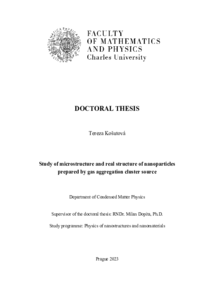Study of microstructure and real structure of nanoparticles prepared by gas aggregation cluster source
Studium mikrostruktury a reálné struktury nanočástic připravených pomocí plynového agregačního zdroje
dizertační práce (OBHÁJENO)

Zobrazit/
Trvalý odkaz
http://hdl.handle.net/20.500.11956/186432Identifikátory
SIS: 203230
Kolekce
- Kvalifikační práce [11978]
Autor
Vedoucí práce
Konzultant práce
Hanuš, Jan
Oponent práce
Rohlíček, Jan
Zákutná, Dominika
Fakulta / součást
Matematicko-fyzikální fakulta
Obor
Fyzika nanostruktur a nanomateriálů
Katedra / ústav / klinika
Katedra fyziky kondenzovaných látek
Datum obhajoby
27. 9. 2023
Nakladatel
Univerzita Karlova, Matematicko-fyzikální fakultaJazyk
Angličtina
Známka
Prospěl/a
Klíčová slova (česky)
nanočástice|plynový agregační zdroj|rtg. rozptyl|reálná strukturaKlíčová slova (anglicky)
nanoparticles|gas aggregation cluster source|x-ray scattering|real structureNáplní předkládané práce je charakterizace nanočástic připravených agregací z plynné fáze. Hlavním cílem je studium jejich mikrostruktury a reálné struktury pomocí metod rozptylu rentgenového záření, doplněných o komplementární techniky, především elektronovou mikroskopii a optická měření. Ukázalo se, že mikrostrukturní parametry, jako například morfologie, a vnitřní a krystalická struktura nanočástic úzce souvisejí s parametry procesu přípravy. U vybraných nanočásticových systémů byl analyzován také jejich teplotní a časový vývoj. K přípravě nanočástic různých materiálů bylo použito vícero plynových agregačních zdrojů. Detailně byla popsána mikrostruktura zlatých, stříbrných a měděných nanočástic. Ohřev vzorků obecně vedl ke snížení množství defektů krystalové struktury a ke koalescenci nanočástic. Z výsledků plyne, že teplotní vývoj je silně závislý na materiálu, ale také na množství nanočástic na substrátu. Například pro měděné nanočástice je koalescence značně omezená, přičemž důvodem je oxidace těchto nanočástic na vzduchu. Oxidace byla pozorována také pro niobové nanočástice. Podrobná analýza postupné oxidace s teplotou ukazuje kompletní amorfizaci struktury před přechodem do substechiometrické fáze oxidu niobu, jejíž struktura byla poprvé určena v této práci a dále přechod do termodynamicky stabilní...
The scope of this work is the characterization of nanoparticles prepared by aggregation from the gas phase. The main focus is on their microstructure and real structure investigated by x-ray scattering methods, although combined with complementary methods such as electron microscopies and optical measurement. The microstructural characteristics, i.e. nanoparticle morphology and crystal and inner structure, were found to be tightly connected with the deposition parameters. For chosen systems, we also analysed the nanoparticle thermal or temporal stability and evolution. Multiple gas aggregation deposition systems were used for the preparation of nanoparticles consisting of different materials. In detail, we studied single-metal nanoparticles - gold, silver and copper. For these, the behaviour with increasing temperature changes with the type of material and also its amount on the substrate. However, in general, the annealing of nanoparticles reduces the amount of structural defects in the crystal structure and causes the coalescence of nanoparticles. In the case of the copper nanoparticles, the coalescence is limited due to the nanoparticle oxidation in the air atmosphere. Similarly, in another system composed of niobium nanoparticles, we observed and described the gradual oxidation during annealing. On the...
